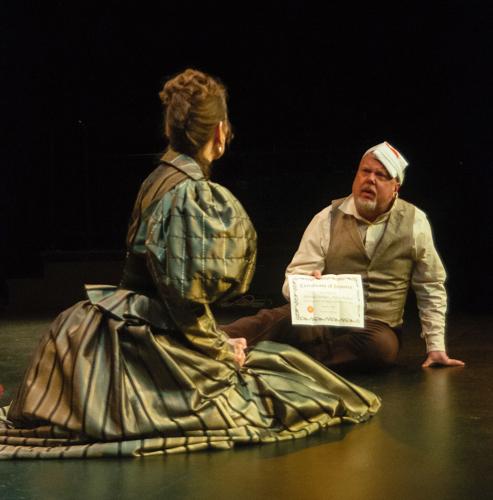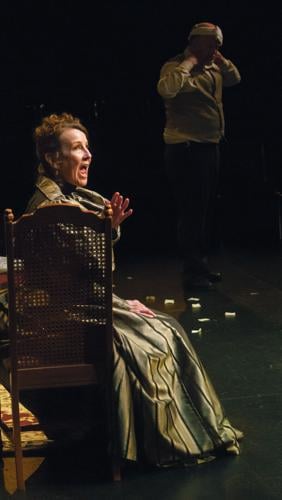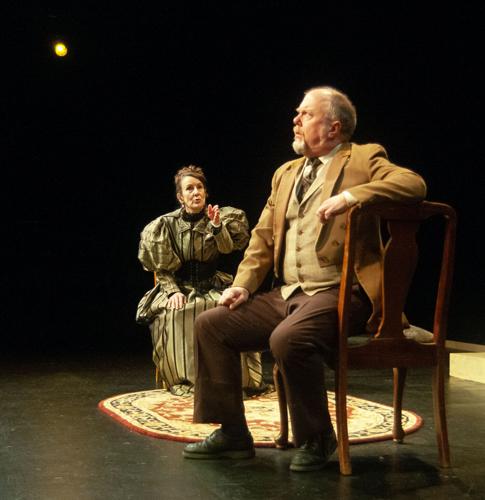“The director pretty much is in charge of everything,” said Tom Burns, director of Columbia Center for the Arts’ first play since the COVID-19 pandemic. As he gives actors interpretive freedom, picks plays, and helps find a dozen creative ways to sit on a chair, Burns’s job is directing the audience’s attention to the actor’s story, he said.
“In some ways,” he said of the four actors in A Doll's House, Part 2, “it’s my job to stay out of their way.”
Burns, who’s been acting since about 1965, earned his master’s in directing from San Diego University almost 50 years ago.
“I learned about stage movement and composition of the actors on the stage. Because it’s my belief that a director’s job is not to provide motivation for the actors, they do that themselves. My job is to direct the audience,” Burns said, drawing their attention to the story’s highlights.
Choreographing the movement of actors across the stage, he can guide the eye to important dialogue. “If you’re looking over here, and somebody said, “It’s a big frog!” and you turn over there ... we missed the most important thing,” he explained. “What I learned was, how to use movement onstage to compose pictures that told the story. Ideally, you should be able to tell what’s going on without hearing any of the dialogue.”
Burns spent four or five years teaching at Southwestern College, before losing the job to budget cuts after California passed Proposition 13 in 1978. “So I got into software,” he said.
He found CCA after retirement to Hood River, and “came down here to find out whether or not they were serious.” Since that 2011 meeting, he’s directed about 11 plays here, and acted in at least 23. “I think the movement that I put in my plays is my strongest point,” Burns noted.
Finding actors was more challenging, back in 2011. “It was difficult to find male actors. There were lots of females, and there still are,” he explained. “But over the course of the years, over the last 10 or 12 years, we’ve built up a pretty good stable of both male and female actors.”
Auditions at CCA are open to anyone.
Before the last two-and-a-half years of COVID-19 closure, Burns directed CCA’s last play, “Constellations.”
“We’re kind of on our way back,” said Burns, who directed plays in Bingen during the closure. “And the actors in my play are all very experienced actors in the Gorge, some of the best available. ... We all acted and directed here. ... So it’s kind of a homecoming for us.”
Returning to a full schedule of performances brings many challenges, said Tim Harkin, CCA’s exective director. “We’re working on building maintenance and updates, as well as bringing our old box office, class registration, and donations systems back online,” he wrote. Recruiting volunteers and board members, building all-important community relationships, and reviving former committees are all part of the process. “Our vision for the theater encompasses multi-disciplinary arts and humanities programming,” Harkins added, including regular theater productions and “a diverse array of local and performing artists.”
Next on the list is Bat Boy: The Musical, in partnership with Columbia Gorge Orchestra Association.
The only regional theater originally built solely to be a theater, CCA had a long-standing theater program before COVID-19.
But Burns also directed at local school auditoriums, the Elks, the Eagles, and the basement of a The Dalles winery.
He chose CCA’s latest play, “A Doll’s House, Part 2,” for its nuanced exploration of gender roles, divorce, and the dynamics of a changing family.
Burns doesn’t see the play as totally feminist; each actor gets a say, expressing conflicting viewpoints. Each actor makes a case for their conflicting view, and this nuanced portrait of divorce, and the complexity of gender inequality and family conflict, is important to Burns.
Lucas Hnath’s sequel to the original 1879 “A Doll’s House,” written by Henrik Ibsen, picks up 15 years after the original plot ends.
“It caused riots, because at the end of the play, Nora walks out on her husband and her three children, she leaves,” Burns said. “She slams the door, and that door slamming was heard all over Europe.”
In a development reminiscent of book-banning, some countries refused to perform “A Doll’s House.”
“The men in the audience are shocked. They didn’t believe a woman could do that,” Burns said. Hnath began asking around in 2017: ‘“Wonder what happened to Nora?” ... and most people said ‘Oh, she probably is dead. I mean, she probably died a few years later. Nothing happened to her,’” Burns said. “And he thought, ‘No.’”
Instead, Hnath’s Nora becomes a well-known writer of books for women, and faces exposure from the bereft husband of a woman who follows Nora’s example. “She was still a married woman,” Burns explained. “And as such, signing the book contracts ... was illegal.” Nora returns to the stage — an empty room, with only two chairs for props — to seek a divorce.
With just two actors and two chairs onstage at a time, the team needed creativity of movement. “Sitting on the chairs — regular, turned sideways, behind the chair, banging the chair on the floor, cross legs, open legs, everything we could think of to use those chairs,” Burns recounted. “That was the challenge.”
Later, Burns will sit through the last dress rehearsal in an empty theater, reacting with quiet, impressed laughter as the four actors’ emotions play out across the empty stage. Meanwhile an engineer, new to the program, sat down and perfected the sound and light cues on the spot.
“The truth is, everybody in the audience completely understands this play,” Burns said. “They understand what marriage is. They understand what divorce is.” The play’s modern language includes heartfelt cursing, which Burns finds interesting; the 15-year gap between play and sequel encompasses a vast change in society’s expectations of family and gender roles. “You might come away thinking that Nora is the reason we’re where we’re at today,” Burns said.
For now, “A Doll’s House, Part 2” is Burns’s whole focus here. “You don’t really think about the next play, whether I’m gonna act or direct or whatever. Until this one’s done,” Burns explained.
With each production, he returns to the idea of directing movement for the audience, but giving creative leeway to actors. He himself has acted under “martinet” directors, and prefers a certain amount of interpretive freedom.
Normally, Burns email copious director’s notes from previous rehearsals to his actors, he said. But on that rehearsal night, he had few. “I was busy watching my play come to life!” he explained.
“A Doll’s House, Part 2” will run from Feb. 23 to March 3. Information online at columbiaarts.org.


























Commented
Sorry, there are no recent results for popular commented articles.